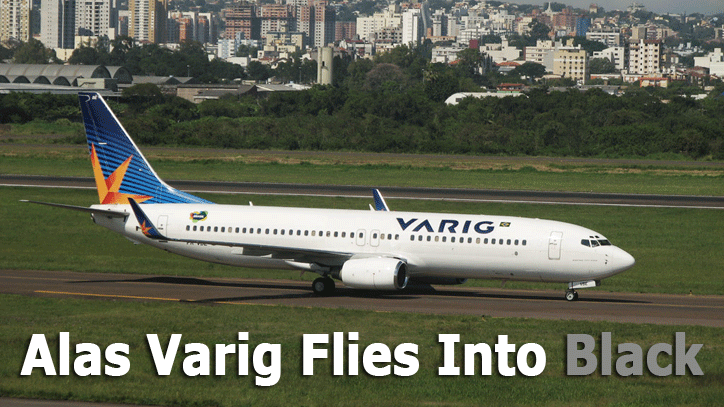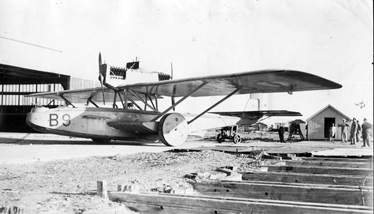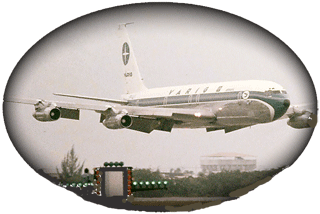
 |
 |
Here again is the first
Varig aircraft, a Dornier Wal flying boat from 1927 and the fabulous
B707 that carried the brand and Brazil into the modern era and the
last Varig tail and tube of the B737-800. |
Don’t look now
but Varig Brasilian Airlines founded in 1927 is finally done and probably
gone forever.
Of course the troubles and bankruptcy of
Varig by now are old news but somewhere in all the turmoil and meltdown,
there were people who would not allow the name and legacy to die as forces
seemed to be lined up to keep the proud old name aloft.
Something of the same thing happened to
another pioneer Pan Am World Airways when it went bust a decade ago, and
even to Swissair recently.
Swissair has been reborn SWISS and is alive
and healthy and even in a tough economy is holding its own as part of
Lufthansa Group.
Pan Am was lifted once by the late Marty
Shugrue, Jr., and then again by Guilford Transportation but now is also
gone, although Guilford apparently has a rousing business selling PAA
flight bags and accessories even today.
It seems revered airlines go away and then
somebody brings them back but the long term results are mostly disappointing.
Right now at once mighty Varig, all that
is left is a website that directs enquiries to GOL.
Even as recently as a year ago Varig was
getting B737-800s to serve South American destinations, but now all of
that is history.
Taking the following time line makes Varig’s
fall just unbelievable.
Varig, a little less than five years ago
in 2004, combined with its subsidiaries Rio-Sul and Nordeste, carried
approximately 13 million passengers annually and had over 11,000 full-time
employees.
As of December 31, 2004, Varig had total
operating revenues of $3.4 billion, of which about $3.15 billion was from
flight operations.
By May 2005, Varig's share of passengers
flying into or out of Brazil was 43% for the South American market, 17%
for the United States market, 35% for the European market, and 48% for
the Asian market.
As of February 2007, Varig held 4.54% of
the domestic Brazilian market, doubling its previous 2.2% share of August
2006, but still well below the 25.02% held in August 2005, and only 21.64%
of the International market, compared to 76.06% one year before. As of
May 2008, Varig held 7.97% of the Brazilian domestic market and 16,68%
of the international market.
On 28 March 2007, Gol Linhas Aéreas
Inteligentes, the parent company of budget carrier Gol Transportes Aéreos,
purchased Varig for US$320 million. Gol announced that Varig would continue
to operate under its original name.
The fleet of 17 aircraft was to be increased
to 34, consisting of 20 Boeing 737 and 14 Boeing 767.
With the new fleet Varig would operate to
12 international destinations: Buenos Aires, Bogotá, Caracas, Frankfurt,
London, Madrid, Milan, Paris, New York, Miami, Mexico City and Santiago.
Varig's international flights would no longer include First Class, and
be only Economy Class and Business Class.
Key domestic services would be operated,
including the Rio de Janeiro to São Paulo shuttle, using VARIG's
124 slots at Congonhas-São Paulo International Airport.
On 21 June 2007, Constantino de Oliveira
Jr., the CEO of Gol Transportes Aéreos announced VARIG's immediate
future plans for its fleet and destinations.
The plan included the acquisition of nine
of the more fuel efficient Boeing 737-800 model and 10 Boeing 767. Constantino
also announced that the airline was in negotiations with both Boeing and
Airbus for the acquisition of either Boeing 787 or Airbus A350 aircraft.
The plan also included flights to Madrid,
London, Paris, Milan, Rome and Mexico City by the end of 2007, and New
York City and Miami in 2008.
But instead last year Varig quit flights
to Frankfurt, Rome, and London, Mexico City, Madrid and Paris, focusing
its network in Brazil and South America.
Varig’s decline went white hot as
the world financial crises deepened and the carrier’s cancelled
flight services left and right since close of 2008.
In April Varig’s online booking service
and frequent flyer program were integrated into Gol.
Varig's website now directs customers to
Gol's website.
Last month in June 2009, VARIG's brand ceased
to operate even a single flight.
Today, what was left of Varig is now branded
Gol Transportes Aéreos.
What are left to us are memories across
82 years.
Here again is the first Varig aircraft,
a Dornier Wal flying boat from 1927 and the fabulous B707 that carried
the brand and Brazil into the modern era and the last Varig tail and tube
of the B737-800.
Geoffrey
|

